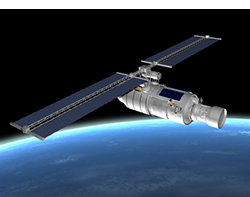5G Narrowband-IoT Everywhere
By: Omar Qaise

By 2025, forecasts suggest that there will be more than 75 billion Internet of Things (IoT) devices in use. Every one of them requires some form of connectivity. However, 85 percent of the world’s surface lacks or has limited access to terrestrial connectivity services. It compels companies to take up satellite connectivity from low Earth orbit (LEO) to go beyond terrestrial networks. Sea, remote, and mining regions are just a few examples of places where satellite connection has the upper hand for both reach and cost.
This lack of connectivity is holding back the growth of the IoT from adding $2 to $3 trillion (USD) to the global Gross Domestic Product (GDP) over the next ten years, according to McKinsey. It is an immense opportunity for satellite IoT to provide complementary services to ground-based cellular and non-cellular IoT networks. Forecasts estimate the value of the satellite IoT market to reach about $6 billion between 2025 and 2031.
We are already seeing the growing usage of satellite-based services across a number of industries, including military and defense, oil and gas, automotive, agriculture, and energy and utilities—especially when low-latency services are required. Compared with larger legacy satellites in geosynchronous equatorial orbit (GEO) by incumbent operators, small satellites in LEO are more effective in connecting, monitoring, and tracking on a real-time basis. To unleash the full potential of the IoT, constellations of small satellites in LEO providing ubiquitous connectivity are indispensable.
Low-latency market and use cases
Many applications for smart metering, precision agriculture, asset tracking, vehicle telematics, artificial intelligence, critical alarms, and environmental monitoring require a latency below ten milliseconds. One key cellular technology for providing services requiring such ultra-low latency and reliable communication is 5G. PWC estimates that 5G technology will add $1,339 billion to the global GDP by 2030, up from $150 billion in 2022.
The speed of 5G would allow sharing of data in real-time across an entire supply chain. A 2022 survey by KPMG found that only 13 percent of businesses currently have complete visibility of their supply chain. Through sensor data and cameras, a company can aggregate an accurate real-time view of asset and equipment locations, as well as control self-driving vehicles and drones. Essentially, it would erase the lag time between when data gets generated to when we can act on it.
One hurdle to accomplishing these figures is investment cost. Most satellite IoT players use proprietary and expensive satellite connectivity technologies to support IoT devices. However, during the last few years, newcomers have started to embrace existing terrestrial wireless IoT connectivity technologies such as the 3rd Generation Partnership Project (3GPP), which is uniting seven telecommunications standard development organizations in a new radio technology developed for the standardization of Narrowband Internet of things (NB-IoT).
Using the 3GPP standard, OQ Technology has launched the world’s first satellite-based NB-IoT constellation providing a global network for 5G connectivity in remote regions with limited or no coverage. The company has also developed a technology using standard mobile chips that are significantly cheaper than the commonly used legacy satellite chips. Its ‘cell tower inside the satellite’ technology enables IoT devices to seamlessly switch between terrestrial and satellite connectivity to overcome connectivity issues without modifying cellular standards.
Creating a 5G IoT constellation
Having achieved the world’s first in-orbit demonstration for NB-IoT waveforms and synchronization procedures in 2019, OQ Technology launched its first mission that gave customers access to full 5G services in 2021. A 6U nanosatellite dubbed “Tiger-2” aboard the SpaceX Transporter-2 rideshare mission, the first commercial 5G IoT satellite in LEO, provided satellite-based IoT and machine-to-machine (M2M) services using low frequencies. It also demonstrated the feasibility of using high frequencies for 5G IoT radio links. To deliver widespread coverage and 5G IoT/M2M communication that is in line with 3GPP recommendations, the satellites use spectrum in the mid band 5G (sub-6 GHz) frequency bands. A year later, a third satellite “Tiger-3” was launched for the same purpose.
Having the satellite in orbit already allowed the provision of basic commercial IoT and M2M services to customers with a focus on Africa, the Middle East, Asia, and Latin America. Tiger-2 also tested a hybrid satellite-cellular user terminal in harsh desert conditions achieving a high level of signal-to-noise ratio. For several weeks, various



















